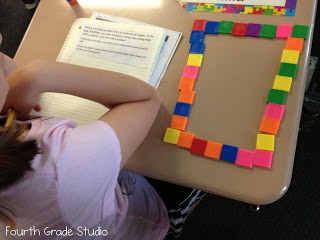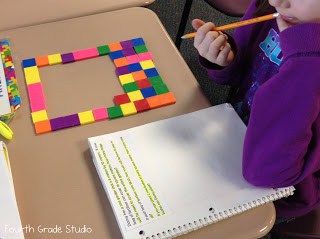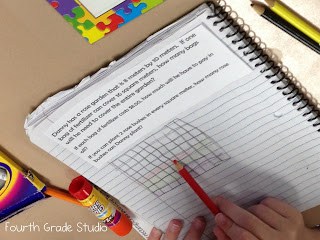As we wrapped up our studies of area and perimeter, I decided to throw in some problem solving to see how the students were applying the things we had explored in our other investigations. You know the ropes–the students work, I walk around and ask questions . . . pull kids for coaching . . . stop class to show cool stuff–the usual.
Well today, I couldn’t help but notice that a few of my petunias dug right into the following problem. I love how willing to just dive in they are–no matter how misguided! (See below)
“Danny has a rose garden that is 8 meters by 10 meters. If one bag of fertilizer can cover 16 square meters, how many bags will he need to cover the entire garden?”
There were two follow up questions, so I knew the students would be busy while I made sure everyone understood the concept. One of the first things I noticed was a select group of students start to build with 1 inch tiles. Great strategy, right?
So I asked this student what her plans were, and she seemed a little . . . ummmm. . . lost. I recommended that she pair up with another child who had gotten out the tiles and to put their heads together for a little while. I said I’d stop back in a bit. When I did, here’s what I saw:
That’s right . . . they were working to FILL the entire array with tiles. I asked them, “So–what are your plans once you have built this garden? What are you trying to figure out?” They weren’t quite sure. I asked them to step away from their tiles and really think. When I returned, they were able to tell me that they needed to know how much fertilizer to buy. After I had probed a little more, I could see a light bulb go on.
“Wait–if I know the garden is 80 square meters, can’t I just divide it into groups of 16 to figure this out?”
Her partner in crime agreed and off they went to solve it NUMERICALLY. I reminded them that tiles are a GREAT solution strategy–but they need to do some thinking first to determine whether or not it is the BEST strategy for any given problem.
I stopped by another student who was trying another approach–she had drawn out the grid (MUCH faster than building the array–so already an improvement) and was color coding it in groups of 16. She was just coloring in the second 16 when she noticed that each 16 was 2 rows–so she didn’t need to continue. She could see the 5 groups.
We shared these two discoveries as a class and talked about how important it is to be always on the hunt for shortcuts and strategies that make our math more efficient and more accurate. I was pleased to see how many students were able to tackle this problem with very little coaching! I think I am going to write up these perimeter and area investigations and include them with a set of word problems. Think there is an interest in that? I hope everyone has a GREAT weekend–it has been a LONG week at school with some major technology issues–like we had no computers/email access for a week and a half–so it is nice to take a deep breath and regroup.
Thanks to those of you who bought from me during the sale as well! I really appreciate your continued support. Watch for a new product coming soon where ALL the profits will be benefiting a charity close to my heart! 🙂








